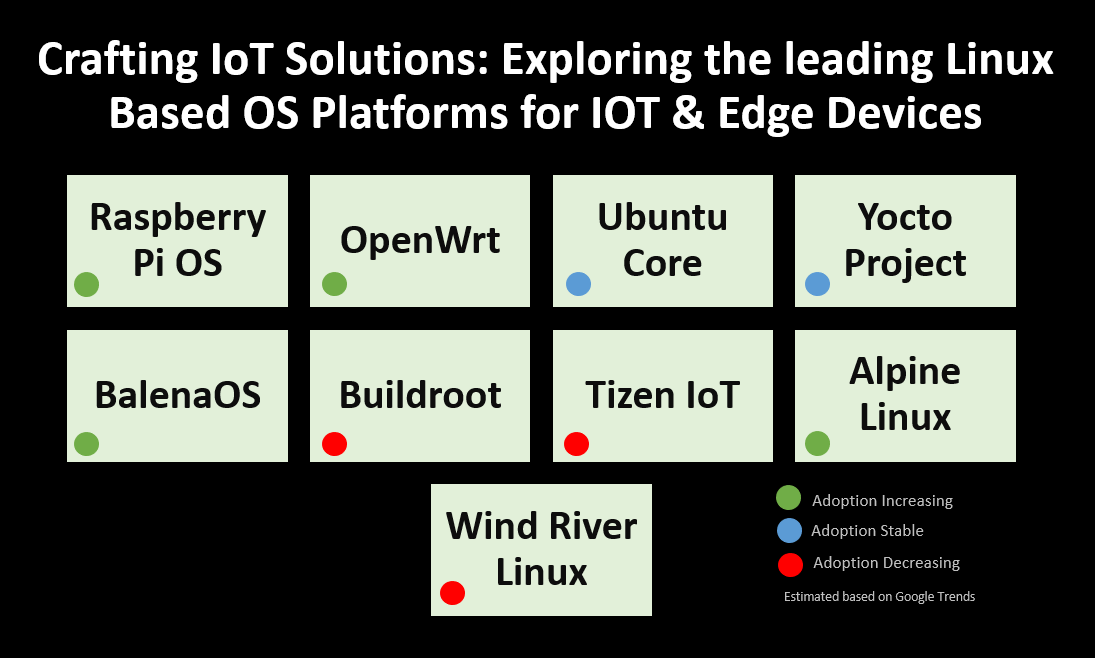The Internet of Things (IoT) and Edge Computing have become integral components of our interconnected world, revolutionizing industries with their ability to gather, analyze, and act upon data in real-time.
A crucial aspect of building effective IoT solutions lies in selecting the right operating system for your connected devices.

In this article, we delve into some of the leading Linux-based OS platforms for IoT and Edge devices, each with its unique features and applications.
Leading Linux-Based OS Platforms
Raspberry Pi OS
Originally designed for the Raspberry Pi single-board computer, Raspberry Pi OS is a lightweight and user-friendly Linux distribution. It has gained popularity not only for educational purposes but also as a versatile choice for IoT applications.
CPU Architecture Supported: ARM
Core Features:
- User-Friendly Interface: Designed with simplicity in mind, making it accessible for beginners.
- Broad Hardware Support: Extensive compatibility with various Raspberry Pi models and peripherals.
- GPIO Access: Enables easy interaction with hardware through General Purpose Input/Output pins.
Industry Adoption: Widely used in educational settings, home automation projects, and small-scale IoT applications.
OpenWrt
OpenWrt is a Linux-based open-source firmware for embedded devices, particularly routers. Its focus on flexibility and customization makes it suitable for a variety of IoT scenarios.
CPU Architecture Supported: MIPS, ARM, x86
Core Features:
- Package Management: Allows users to install additional software packages for customization.
- Network Management: Advanced networking features, including support for VPNs and Quality of Service (QoS).
- Security: Regularly updated to address security vulnerabilities.
Industry Adoption: Predominantly used in networking devices, it is a popular choice for custom router firmware and IoT gateways.
Ubuntu Core
Developed by Canonical, Ubuntu Core is a minimal, container-based version of the Ubuntu Linux distribution. It focuses on security and application isolation, making it suitable for IoT deployments.
CPU Architecture Supported: ARM, x86
Core Features:
- Snap Packages: Applications run in isolated containers, enhancing security and reliability.
- Transaction Rollback: Enables easy recovery from failed updates or installations.
- Integration with Ubuntu Ecosystem: Benefit from the extensive Ubuntu software and support.
Industry Adoption: Ubuntu Core is employed in smart devices, robotics, and industrial IoT applications.
Yocto Project
Yocto Project is not an OS itself but a collaborative project that provides tools and templates to create custom Linux distributions for embedded systems. It is favored by those seeking a tailored OS for their specific IoT needs.
CPU Architecture Supported: Various architectures supported through customization.
Core Features:
- Customization: Allows building lightweight and optimized Linux distributions for specific hardware.
- Layers Concept: Modular approach for adding and customizing components.
- BitBake Build System: Automates the build process for embedded Linux.
Industry Adoption: Widely used in diverse IoT applications, ranging from consumer electronics to industrial automation.
BalenaOS
BalenaOS is designed for managing containerized applications on edge devices. It facilitates easy deployment and updates for containerized IoT applications.
CPU Architecture Supported: ARM, x86
Core Features:
- Container-Based: Utilizes containerization for application isolation and portability.
- BalenaCloud Integration: Simplifies remote device management and updates.
- Multi-Architecture Support: Enables deployment on a variety of hardware platforms.
Industry Adoption: Commonly used in edge computing scenarios, such as fleet management for IoT devices.
Buildroot
Buildroot is a simple and efficient tool for generating embedded Linux systems. It is designed to be customizable and lightweight, making it suitable for resource-constrained IoT devices.
CPU Architecture Supported: Various architectures supported through customization.
Core Features:
- Simplicity: Easy-to-use framework for building custom embedded Linux systems.
- Fast Build Process: Streamlined build process for quick development cycles.
- Configurability: Fine-grained control over components and features.
Industry Adoption: Often utilized in IoT applications requiring minimalistic and custom-built Linux distributions.
Tizen IoT
Tizen is an open-source, Linux-based operating system initially developed for mobile devices. Tizen IoT is an extension focusing on the Internet of Things.
CPU Architecture Supported: ARM, x86
Core Features:
- Unified Platform: Tizen IoT provides a unified platform for various types of IoT devices.
- IoTivity: Standardizes communication between IoT devices.
- Smart Device Integration: Supports integration with smart TVs, wearables, and other devices.
Industry Adoption: Tizen IoT finds applications in smart homes, wearables, and multimedia devices.
Alpine Linux
Alpine Linux is a lightweight, security-oriented Linux distribution. Its small footprint and focus on simplicity make it an excellent choice for resource-constrained IoT devices.
CPU Architecture Supported: x86, ARM
Core Features:
- Musl libc and BusyBox: Reduces system overhead and enhances efficiency.
- Security Emphasis: Minimizes vulnerabilities through a proactive security stance.
- Container Support: Lightweight containerization support for efficient deployment.
Industry Adoption: Commonly used in scenarios where minimal resource usage and security are critical, such as edge devices.
Wind River Linux
Wind River Linux is a commercially supported embedded Linux distribution designed for real-time and safety-critical systems. It is often used in industrial and automotive applications.
CPU Architecture Supported: ARM, x86
Core Features:
- Real-Time Capabilities: Supports real-time features for time-sensitive applications.
- Safety Certification: Meets safety standards for applications in critical sectors.
- Professional Support: Offers commercial support and services.
Industry Adoption: Prevalent in automotive, aerospace, and industrial IoT applications where real-time and safety-critical features are crucial.
Conclusion
The choice of an IoT operating system depends on factors such as hardware requirements, customization needs, and industry-specific considerations.
Each Linux-based OS platform discussed here offers unique features catering to diverse IoT and Edge Computing scenarios, from educational projects and smart homes to industrial automation and safety-critical applications.
As the IoT landscape continues to evolve, these operating systems play a pivotal role in shaping the future of connected devices.